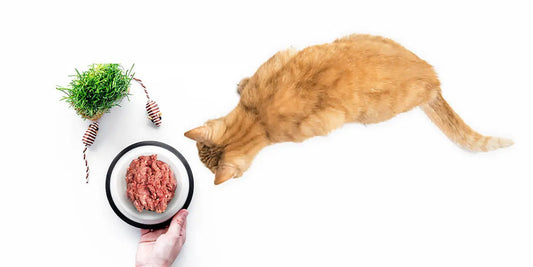
What Bones Are Good for Dogs? Safe Tips for Happy Pets
Written by Darwin's
So, you’ve heard the phrase “give a dog a bone”, and you thought about doing it. Most pet parents struggle with the topic of what bones are good for dogs. There is a reason why dogs and bones is such a cliché, dogs do need bones. However, it is not as simple as throwing a bone to a dog. There are different kinds of bones, and each has an important benefit.
Bones are a good source of minerals and nutrients that help satisfy your dog’s appetite. Chewing bones stimulates saliva enzymes and prevents plaque buildup on teeth and gum disease. At the same time, chewing bones can pose risks and dangers to dogs. So, while the short answer is yes, dogs can have bones, let’s get into the longer explanation of what bones are good for dogs.
Are Bones Good for Dogs?
When given properly, bones offer many benefits to dogs. Pet parents need to make a difference between edible, meaty bones, and recreational bones. Edible bones are those that dogs can eat as whole bones. There are trace minerals in these bones that help with nutrition. Raw meaty bones are better than soft chews, but they cannot be fully edible. Dog treats like raw meaty bones work as a natural toothbrush for dogs, helping them clean their teeth. Recreational bones are great for working dogs, providing mental stimulation. When we talk about the benefits of bones for dogs, there are three types of benefits: nutritional, health, and mental.
Nutritional benefits of bones for dogs
Bones are a great source of minerals, vitamins, protein, and amino acids. Consuming bones helps dogs with their muscle development, bone growth, and regeneration of the skeletal system. Some of the minerals found in bones are magnesium, phosphorus, and calcium. Last, but not least, bones contain marrow, a source of collagen, an essential nutrient for healthy joints.
Health Benefits of bones for dogs
Not all dogs tolerate having their teeth brushed. Chewing on raw and meaty bones serves the function of brushing and flossing teeth. Raw bones (like our beef femur bones for dogs) also provide a cleansing effect on the digestive tract and provide a workout for the jaw.
Chewing can also be especially beneficial as part of a senior dog care routine, helping older dogs maintain oral health and stay mentally stimulated as they age.
Behavioral benefits of bones for dogs
Chewing and gnawing on bones provide hours of enrichment, entertainment, and mental stimulation for dogs. Chewing is a natural behavior for dogs. Regular chewing provides a calming effect, as the activity releases endorphins, the happy hormones. Dogs feel pleased, happy, and calm, reducing risks for potential anxiety.
What Are Some Safe Bones For Dogs?
Before giving dogs any bones, you should always consult with a veterinarian. Not all dogs can chew or eat bones, for example, apartment dogs like Maltese and Bichon Frise. There are important considerations when giving dogs a bone. First, let’s talk about some safe bones for dogs.
-
Duck and goose feet are great treats for small to medium dogs. These bones do not splinter, since they are not cooked. Full of beneficial cartilage, wash them thoroughly before giving them to dogs.
-
Freeze-dried raw chicken hearts are another delicious and tasty treat for smaller canines and a quick snack for medium dogs.
-
Raw, large beef femur bones are safe and beneficial for dogs. They provide plenty of nutrients and dental benefits. However, pet owners should always choose the right type and size and supervise their dogs while chewing.
-
Chicken or duck necks for dogs are a healthy and beneficial chew that provides dental health and joint health support. They are also a natural source of calcium. However, give dogs only raw chicken necks. Cooking can make them brittle and splinter.
-
Lamb ribs are a tasty chew for dogs and a complementary feed. Dog owners can give them as part of a natural raw diet. Great for cleaning teeth, lamb ribs are a natural alternative to rawhide treats.
-
Recreational bones like beef knuckle bones and marrow bones should be given only for chewing, not eating. They are great for large dogs and provide hours of chewing entertainment.
-
For variety in protein sources, you might also wonder, “Is venison good for dogs?” Yes, venison dog treats are lean, digestible, and rich in nutrients, making it a great option for dogs with food sensitivities.
Important Considerations When Giving Bones to Dogs
There are several factors that can determine whether the bones are good for your dog or not. First and foremost, pay attention to the size. Bones should be large enough to prevent dogs from swallowing them. Always get bones that are proportional to the dog’s size.
Next, get bones from a reputable source. There are too many potential health risks, so make sure you get the premium quality.
Always supervise your dog while chewing on bones. Even with safe bones, there is always the risk of broken teeth, cuts, or bone splinters.
Can You Leave a Dog Alone with Bones
Pet owners should never leave a dog alone with bone, no matter how often they have previously eaten a bone. Dogs may swallow the bone or turn it into pieces. If part of the bone is coming away or getting too small, pet parents should take it away from the dog and give them a high-value treat in return. Never take away a bone from a dog without giving anything in return, as you might inadvertently cause resource guarding.
Dogs will naturally walk away from the bone once they are done with it. If the bone looks fine afterward, wrap it in a food bag and put it in the fridge. Dogs might have another gnaw at it after a couple of days. However, always supervise a dog with a bone.
What Bones Are Not Safe For Dogs
Not all bones are good for canines. Pet owners should consult with a veterinarian. However, generally speaking, three types of bones are not safe.
Cooked Chicken and Turkey Bones
Cooked chicken and turkey bones can break easily and cause problems in the digestive tract. Small bones can also get stuck in the throat.
T-Bones
T-bones have a natural shape that poses a risk of getting stuck in the throat. It can cause swelling and block the airway, preventing dogs from breathing.
Small Bones and Circular Bones
Never give bones to dogs that are smaller than their mouth. It can result in a choking hazard and trauma to the mouth and intestinal tract. Circular bones can become lodged in the lower jaw, causing anxiety in pets.
Potential Health Risks When Giving Bones
There are plenty of benefits of giving bones to dogs. However, on the other side, there are also potential risks and hazards pet parents should consider.
Fatty bones can cause pancreatitis
Fatty bones, for example, pork rib bones, are high in fat. Dogs cannot handle the amount of saturated fat on fatty bones. Consuming and gnawing on fatty bones can increase the risk of pancreatitis, an inflammation of the pancreas.
Ranging from mild to severe, symptoms of pancreatitis include vomiting, lethargy, diarrhea, and loss of appetite.
Cooked bones can splinter
Cooked bones splinter into shards and if dogs eat it, they can choke on the tiny pieces. Bone shards can cause damage to the dog’s mouth, throat, or intestines. If a dog eats cooked bones, call your vet for advice or schedule an appointment.
Choking hazards
When dogs gnaw on a bone, they might chew it down into small pieces. These fragments are a major choking hazard. Bone fragments can get lodged into the throat, blocking the airways and resulting in an emergency visit to the vet. These chunks are sharp and can puncture and cut the inside of a dog’s mouth, tongue, stomach, and intestines.
Might cause blockages
There is always a chance of bone chunks getting stuck in the intestines and causing blockages. When a bone fragment is too large to pass through the gut, it can obstruct the flow of all other digested foods. Obstructions can lead to illnesses, and in severe cases, death.
Bones can irritate the stomach
Bones and their marrow can cause diarrhea and irritable bowel syndrome. Dogs should consume bones in moderation. Canines with sensitive stomachs should stay away from bones.
How Do I Know What Bone To Give To My Dog?
Before giving any bone to your dog, it is best that you consult with a veterinarian. Consult with a professional to prevent putting your dog’s health in danger by giving them an item that can cause injury or harm their health in any other way.
Bones do provide benefits to dogs, including dental health, mental stimulation, and more, but they come with risks. Responsible pet owners should always weigh the potential benefits against the risks. That is the best way to make an informed decision. In the end, consulting with a veterinarian is crucial to determine whether giving bones to your dog is safe and appropriate.
How Often Should You Give Bones to Dogs?
If a dog is on a raw diet, bones should make up to 10% of their diet. For whole bones with meat around it, it should make up around 30% of a dog’s diet. In the latter case, the meat and the bone are delivered together.
When to Throw the Bone Away
When dogs finish off gnawing the bone, pet owners should check the situation. If all the marrow and meat are gone, the bone becomes harmful. Do not ever wash a bone and fill it with peanut butter or similar options. The moment the marrow and meat are gone, throw the bone away.
Darwin’s Bone Treat for Dogs
At Darwin’s, we understand and recognize the need for dogs to chew and gnaw on things. It is a natural behavior for dogs. As descendants of wolves, dogs love chewing, as it provides mental stimulation. At the same time, we care for your dog’s safety and we want to make sure pets get premium products. By understanding the different types of bones and how to serve them responsibly, you can enrich your dog’s life while keeping them safe and healthy. We’re committed to providing high-quality dog treats and raw dog food that support your dog’s well-being, so they can enjoy their natural instincts with peace of mind.


